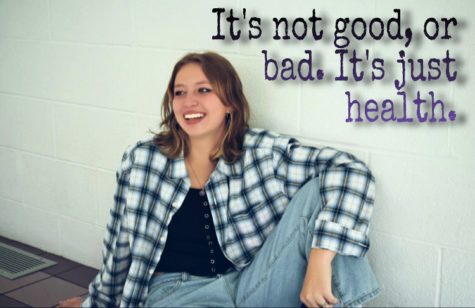Mental health in the classroom, what a teacher has to say about it
Photo of Dakota St. Clair by Maci Lesh. Photo editing done in the IOS app, Picsart.
Including emotional and mental health in the classroom
Mental and emotional health is becoming increasingly important to today’s society. The last year and a half have allowed everyone to really consider how well they take care of themselves. Physically, of course, but just as importantly, mentally and emotionally. How does everyone cope, how does everyone deal with things that seem like nothing daily, but once they add up, feel like this tremendous emotional burden on their shoulders? Students have felt this pain all too clearly over their time spent locked up in their homes, and just in general. And now everyone is coming back to school and society has opened up, how do teens deal with the particular emotional heartache of the past year? Counselors are a wonderful resource, unquestionably, but with more than 1,860 students, and only about nine counselors, students need more resources. That’s why incorporating mental and emotional health into basic education is crucial.
Defining mental and emotional health:

People often equate mental health with having mental issues; however, everyone has mental health. Some people are healthier than others, while others really struggle. This isn’t a negative thing, of course, any more than physical health improving or worsening. It’s just a part of life, but just like people need help when they get sick, they also need guidance when they aren’t feeling well mentally, too.
Fortunately, teachers strive every day to build those connections with students. Scott Hertel, a science teacher at A-West, has worked in Foster Care and Treatment Centers and has a bachelor’s degree in psychology.
Hertel reinforces this by saying, “In my work and definitely with teaching, I’ve always been really big on the relationship piece, right? It’s not just about, you know, working with and doing the job…part of the job is…you’re building relationships and getting to know each other and then that helps I think, translate into building those connections that can help with you know…if there’s challenges that come up. You know you feel better talking to someone that you know or that you feel like gets you, rather than some stranger or someone that’s just doing a job.”
Hertel agrees that students have problems just as much as adults do. “Being aware of the stresses and challenges and life events that students go through, I think sometimes
adults can just ignore that. ‘No, you’re just students– you don’t –you don’t really know what hard life is,’ and that’s not true.”
Incorporating mental and emotional health in classrooms
Various people would say that it isn’t a school’s or a teacher’s job to assist with mental health. Hertel disagrees: “School is meant to educate, right? That’s the goal. But, I think we often get really focused on education equals memorizing facts, and being able to regurgitate answers on a test. So, I think it’s important to teach to the whole child, the whole youth, the whole person so that we’re helping build academic skills, we’re helping build social skills, we’re helping build emotional intelligence, and you know, social connections. And so, allowing for that to be a valid thing that schools can do, not just teaching the content.”
Taking care of mental and emotional health
School can help, according to Hertel: “Things like advisement, like it’s amazing that A-West has dedicated time each week to [say] ‘Look, we need to build these connections and skills and have time to get extra help and communicate.’ That’s a great thing that not all schools do.”
He elaborates on aspects out of the classroom as well. Hertel is a strong believer in the Four Pillars of Learning by Stanislas Dehaene which are made up of Attention, Active Engagement, Error Feedback, and Consolidation, the latter of which he elaborates on.
“Consolidation is a huge peice that often gets skipped, and that happens mostly during sleep, right? Sleep is really important and our brain is doing lots of housework and cleaning, and there’s neurochemicals in there that are helping to get rid of some of the junk to make those connections stronger, [and] to make those important things stand out, and so that is actually something that I’ve been trying to highlight with some of my classes is teenagers sleep schedules get all kind of messed up…and so one of the things I try to advocate for is really getting into that good sleep hygiene and making sure you get into good routines and really pay attention to how you’re sleeping ’cause that has a huge effect on your mental and physical health.”
Taking care of minds and hearts is so important, just as important as taking care of everything else. Students deal with difficult problems too and considering they spend a lot of time in school, it only makes sense to incorporate that into the classroom. School is there to teach students basic fundamentals such as reading, doing math, and about US history. These are great skills, but so are the deeper ones. Teaching students to think critically, to problem-solve, to learn from their mistakes. That’s what school is really about. Not just teaching students numbers and figures, but teaching how to be good humans, how to be the best people they can be.
Mental Health Resources:
National Suicide Prevention Lifeline

Maci is a senior and a four-year member of The Westwind staff, now in her second year as Editor-in-Chief. She fell in love with journalism freshman year...




Norah Caskey • Oct 27, 2021 at 8:54 pm
This is beautiful! I love the Westwind, and your stories are very interesting. Maci, your writing is beautiful. Keep it up! I appreciate the hard work it takes to write an article.